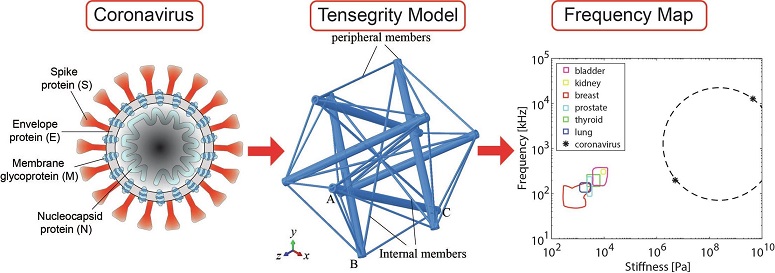COVID-19 News: Harnessing Sound Frequencies For SARS-CoV-2 Inactivation - A Breakthrough Study From Malaysia
Thailand Medical News Team Aug 18, 2023 1 year, 8 months, 2 days, 12 hours, 49 minutes ago
COVID-19 News: In late 2019, the world was blindsided by the emergence of COVID-19, a novel and highly contagious respiratory illness caused by the severe acute respiratory syndrome coronavirus 2 (SARS-CoV-2). Since then, the global battle against this pandemic has primarily centered around vaccination efforts.
 Graphical Abstract
Graphical Abstract
However, the SARS-CoV-2 virus continues to evolve. Latest
COVID-19 News reports indicate that the present Omicron sub-lineages and recombinant variants are mutating at an unprecedented rate and spawning hundreds of new sub-lineages each month! As such, it becomes crucial to explore alternative strategies to combat the SARS-CoV-2 virus and not to rely on vaccination alone. One intriguing avenue of research is the use of sound frequencies, a concept known as sonification, to disrupt and inhibit the virus's activity. A groundbreaking study conducted by researchers at Universiti Malaysia Sarawak has unveiled a novel approach to combat SARS-CoV-2 by harnessing the resonant frequencies of the virus.
The Tensegrity Model: Unveiling the Resonant Frequency
The study introduces a revolutionary technique known as the "tensegrity method" to determine the resonant frequency of the coronavirus. The tensegrity model is chosen for its ability to effectively capture various biomechanical behaviors exhibited by different biological entities. This modeling approach offers a simplified yet accurate representation of the virus's mechanical properties, allowing researchers to identify the resonant frequencies that trigger its structural failure.
Coronaviruses: Structure and Vulnerabilities
Coronaviruses are enveloped viruses characterized by their spike (S), envelope (E), and membrane (M) proteins. These components are encased within a lipid bilayer, giving the virus its distinctive appearance resembling a solar corona. The virus's genetic material, a positive-sense single-strand ribonucleic acid, is housed within an icosahedral shell structure. Understanding the structural vulnerabilities of the virus is crucial for developing effective inactivation methods.
Sonication: Exploiting Resonance for Virus Inactivation
Sonication, a process involving the application of specific sound frequencies, has shown promise in disinfection and medical therapies. By exposing the virus to its resonant frequency, researchers induce large-scale deformations that lead to structural failure and, ultimately, virus inactivation. Thi
s approach has been successfully applied in various fields, including decontamination of bacteria and triggering cancer cell death.
Vibration Therapies and Their Biomedical Applications
Vibration-based therapies have been widely employed in medical practices for therapeutic purposes. Techniques like kidney stone crushing, physical therapy, and pain mitigation have leveraged vibrations for their beneficial effects. Similarly, magnetic exciters and electromagnetic energies have been used to stimulate neurons, induce muscle relaxation, and target cancerous cells selectively. These principles underscore the potential of harnessing specific frequencies to manipulate biological structures.
Resonant Phenomenon: From Material Sciences to Viral Inactivation
The concept of resonance, widely observed in structural and material science studies, plays a crucial role in viral inactivation through sonication. Just as harmonic vibrations can induce structural damage in materials, the resonant frequencies of the coronavirus can lead to its envelope fracturing, rendering the virus inert. This resonant load-induced failure mechanism offers a powerful approach to combat the virus's spread.
Modeling the Resonant Frequency: Tensegrity's Simplicity and Efficacy
While various modeling techniques exist, the study highlights the efficacy of the tensegrity model for characterizing the mechanical behaviors of biological entities. Unlike complex models, the tensegrity model offers simplicity and computational efficiency, making it ideal for parametric investigations. The model's ability to accurately predict resonant frequencies and deformation patterns adds to its appeal for studying viruses' inactivation.
Implications for COVID-19 Treatment
The research's main contribution lies in its pioneering exploration of using the tensegrity model to determine the resonant frequency of the coronavirus. By identifying the range of resonant frequencies that induce structural failure in the virus, researchers open the door to potential alternative treatments for COVID-19. This approach could offer a cost-effective, time-efficient, and labor-friendly solution for combating the virus, especially in emergency situations where rapid results are crucial.
Conclusion
As the world continues to grapple with the ongoing threat of COVID-19 and its evolving variants, innovative solutions are imperative. The Malaysian study's groundbreaking use of sound frequencies to inhibit SARS-CoV-2 through resonant inactivation presents a promising avenue for future research and therapeutic development. By harnessing the power of resonance and leveraging the simplicity of the tensegrity model, researchers are paving the way for novel disinfection methods and therapeutic approaches that could revolutionize our fight against the pandemic. As we strive to protect global health, interdisciplinary collaborations and bold scientific endeavors will undoubtedly shape the course of our battle against infectious diseases.
The study findings were published in the peer reviewed journal: Alexandria Engineering Journal.
https://www.sciencedirect.com/science/article/pii/S1110016823007056
For the latest
COVID-19 News, keep on logging to Thailand Medical News.
